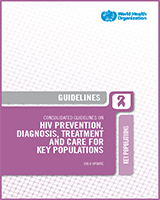| HIV PREVENTION |
|---|
|
1
| The correct and consistent use of condoms with condom-compatible lubricants is recommended for all key populations to prevent sexual transmission of HIV and sexually transmitted infections (STIs). |
|
2
| Oral pre-exposure prophylaxis (PrEP) containing tenofovir disoproxil fumarate (TDF) should be offered as an additional prevention choice for key populations at substantial risk of HIV infection as part of combination HIV prevention approaches.
NEW RECOMMENDATION |
|
3
| Post-exposure prophylaxis (PEP) should be available to all eligible people from key populations on a voluntary basis after possible exposure to HIV. |
|
4
| Voluntary medical male circumcision (VMMC) is recommended as an additional, important strategy for the prevention of heterosexually acquired HIV infection in men, particularly in settings with hyperendemic and generalized HIV epidemics and low prevalence of male circumcision. |
| HARM REDUCTION FOR PEOPLE WHO USE DRUGS |
|---|
|
5
| All people from key populations who inject drugs should have access to sterile injecting equipment through needle and syringe programmes. |
|
6
| All people from key populations who are dependent on opioids should be offered and have access to opioid substitution therapy. |
|
7
| All people from key populations with harmful alcohol or other substance use should have access to evidence-based interventions, including brief psychosocial interventions involving assessment, specific feedback and advice. |
|
8
| People likely to witness an opioid overdose should have access to naloxone and be instructed in its use for emergency management of suspected opioid overdose.
NEW RECOMMENDATION |
| HIV TESTING AND COUNSELLING (HTC) |
|---|
|
9
| Voluntary HTC should be routinely offered to all key populations both in the community and in clinical settings. Community-based HIV testing and counselling for key populations, linked to prevention, care and treatment services, is recommended, in addition to provider-initiated testing and counselling. |
| HIV TREATMENT AND CARE |
|---|
|
10
| Key populations living with HIV should have the same access to antiretroviral therapy (ART) and to ART management as other populations. |
|
11
| All pregnant women from key populations should have the same access to services for prevention of mother-to-child transmission (PMTCT) and follow the same recommendations as women in other populations. |
| PREVENTION AND MANAGEMENT OF COINFECTIONS AND CO-MORBIDITIES |
|---|
|
12
| Key populations should have the same access to tuberculosis (TB) prevention, screening and treatment services as other populations at risk of or living with HIV. |
|
13
| Key populations should have the same access to hepatitis B and C prevention, screening and treatment services as other populations at risk of or living with HIV. |
|
14
| Routine screening and management of mental health disorders (depression and psychosocial stress) should be provided for people from key populations living with HIV in order to optimize health outcomes and improve their adherence to ART Management can range from co-counselling for HIV and depression to appropriate medical therapies. |
| SEXUAL AND REPRODUCTIVE HEALTH |
|---|
|
15
| Screening, diagnosis and treatment of sexually transmitted infections should be offered routinely as part of comprehensive HIV prevention and care for key populations. |
|
16
| People from key populations, including those living with HIV, should be able to experience full, pleasurable sex lives and have access to a range of reproductive options. |
|
17
| Abortion laws and services should protect the health and human rights of all women, including those from key populations. |
|
18
| It is important to offer cervical cancer screening to all women from key populations. |
|
19
| It is important that all women from key populations have the same support and access to services related to conception and pregnancy care, as women from other groups. |
